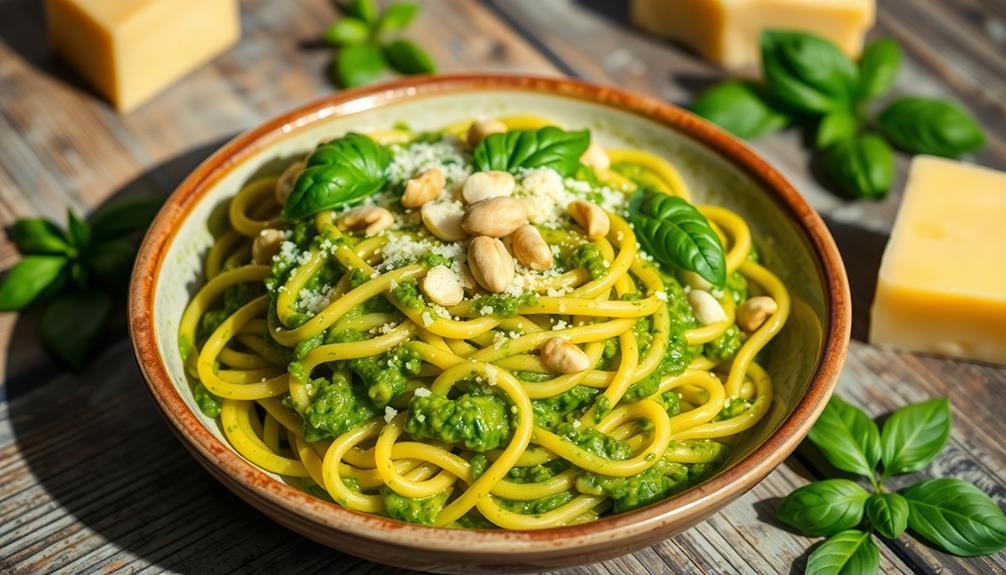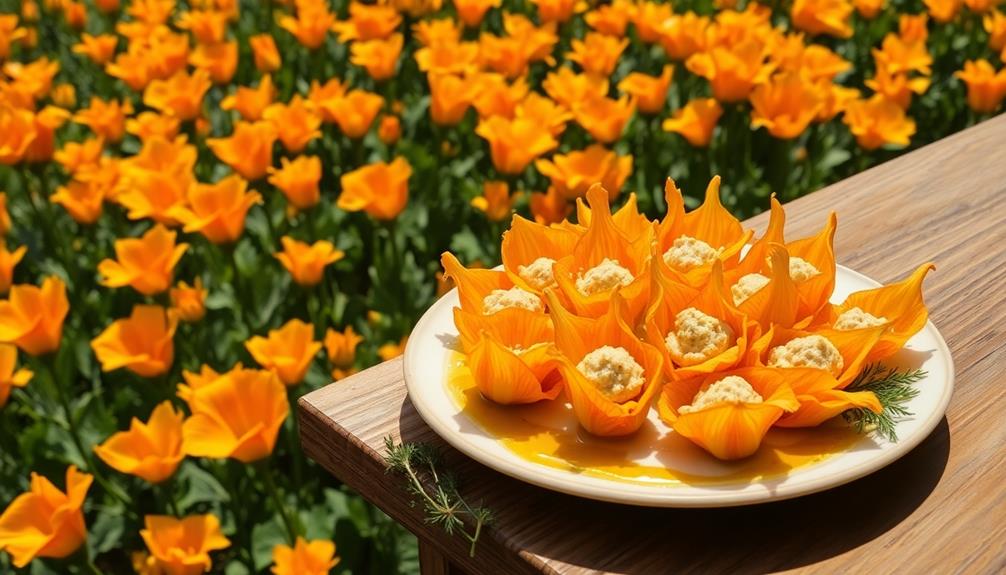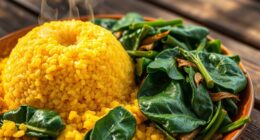Roasted chestnuts are autumn's wild treat, carrying the scent of nostalgia and the warmth of seasonal festivities. Their origins trace back to ancient civilizations, where these starchy nuts were revered as sacred plants. Today, you can still find street vendors selling this beloved delicacy, its smoky aroma wafting through the crisp air. The process of roasting is an art – scoring, cooking, peeling – unlocking the sweet, creamy flavor and unique texture. More than just a snack, roasted chestnuts evoke cherished memories and represent the very essence of fall. If you'd like to learn the full story behind this autumnal delight…
Key Takeaways
- Roasted chestnuts are a beloved autumn delicacy with a rich cultural history, tracing back to ancient civilizations and associated with seasonal traditions and celebrations.
- The roasting process involves scoring, heating, peeling, and cooling the chestnuts to achieve a warm, nutty aroma and a delicate balance of crunch and creaminess.
- Enjoying warm roasted chestnuts evokes nostalgia, comfort, and a strong connection to the sights, smells, and flavors of the changing seasons.
- Nutritionally, chestnuts offer a unique profile, featuring fiber and vitamins, and can be incorporated into various culinary applications beyond a simple snack.
- The enduring popularity of roasted chestnuts demonstrates their timeless appeal, as they continue to be celebrated and shared in markets, fairs, and gatherings worldwide.
History
Chestnuts have a rich history, tracing their origins back to ancient times. These versatile nuts were a staple food for many civilizations, from the Greeks and Romans to the Native Americans. In fact, the chestnut tree was revered as a sacred plant in several cultures, with its wood and nuts used for everything from construction to culinary delights.
Throughout the centuries, chestnuts have been prized for their nutritional value, versatility, and distinctive flavor. They were a crucial food source during times of scarcity, providing a reliable and satisfying source of sustenance.
As trade routes expanded, the chestnut's popularity spread, becoming a beloved treat in many parts of the world, including Europe and Asia.
Today, the beloved chestnut remains a symbol of autumn's bounty, evoking nostalgic memories of roasting them over an open fire or incorporating them into traditional recipes. Their enduring appeal is a testament to the chestnut's enduring place in human history and culture.
Recipe
Roasted chestnuts are a beloved winter treat, filling the air with their warm, nutty aroma. The process of roasting chestnuts is simple, yet it requires a bit of care and attention to ensure the perfect result. Whether enjoyed as a snack or incorporated into holiday recipes, roasted chestnuts are a delightful addition to the season.
Roasting chestnuts is a straightforward task, but it's essential to follow a few key steps to achieve the desired outcome. The goal is to create a crisp, caramelized exterior while maintaining a soft, creamy interior.
- Fresh, high-quality chestnuts
- A sharp knife
- A baking sheet or roasting pan
- Oven preheated to 400°F (200°C)
Begin by scoring the chestnuts with a sharp knife, making a shallow X-shaped cut across the flat side of each nut. This will allow the steam to escape during the roasting process, preventing the chestnuts from exploding. Arrange the scored chestnuts in a single layer on a baking sheet or roasting pan.
Roast the chestnuts in the preheated oven for 20-25 minutes, or until the shells have opened up and the nuts are tender when squeezed. Halfway through the roasting time, give the pan a gentle shake to ensure even cooking.
Once the chestnuts are done, remove them from the oven and let them cool for a few minutes before peeling and enjoying.
When it comes to roasting chestnuts, timing and technique are crucial. Ensure that the oven is preheated to the correct temperature, and keep a close eye on the chestnuts to prevent them from burning.
Remember that the size and freshness of the chestnuts can affect the roasting time, so adjust accordingly. With a little practice, you'll be able to achieve perfectly roasted chestnuts every time.
Cooking Steps
First, carefully score the chestnut shells with a sharp knife to allow steam to escape during roasting.
Next, roast the chestnuts in the oven until they're tender and the shells start to peel back.
Step 1. Carefully Score Chestnut Shells
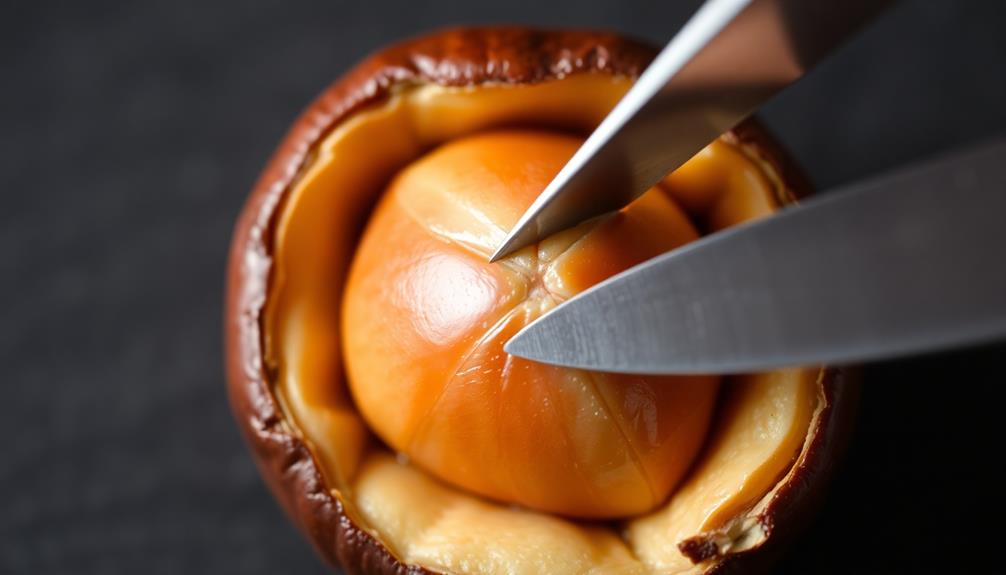
Before you begin roasting, it's crucial to carefully score the chestnut shells. Use a sharp knife to make a shallow X-shaped cut across the flat side of each nut. This scoring allows the steam to escape during the roasting process, preventing the chestnuts from bursting open.
Take care not to cut too deeply, as this can cause the nuts to dry out. Scoring the shells also makes it easier to peel the chestnuts once they're roasted. Work methodically, scoring each chestnut one by one.
This simple prep step ensures the chestnuts cook evenly and their delicate texture is preserved. With the shells scored, you're ready to move on to the roasting stage. Preheat your oven and get ready to fill your kitchen with the irresistible aroma of freshly roasted chestnuts, a true taste of autumn.
Step 2. Roast Chestnuts in Oven

With the chestnuts' shells carefully scored, you can now start roasting them in the oven.
Preheat your oven to 400°F (200°C). Arrange the scored chestnuts in a single layer on a baking sheet. Make sure they're not touching each other.
Roast the chestnuts for 15-20 minutes, turning them halfway through the cooking time. You'll know they're done when the shells have opened up, and the interiors are tender and creamy.
Be cautious when handling the hot chestnuts. Use a pair of tongs or oven mitts to transfer them to a serving bowl.
Serve the roasted chestnuts warm, and enjoy their rich, nutty flavor as a delightful autumn treat. The roasting process caramelizes the natural sugars, creating a delightful balance of sweetness and earthiness.
Savor the chestnuts on their own or pair them with a glass of mulled wine for a cozy, seasonal experience. To fully embrace the winter season, consider the benefits of pine needle tea to accompany your chestnut indulgence. Pine needle tea is known for its high levels of vitamin C and antioxidants, making it a healthy and refreshing beverage choice. The earthy, piney flavor of the tea complements the nutty taste of the chestnuts, creating a truly magical combination for a cozy night in. So, embrace the warmth and flavor of this delightful pairing and elevate your seasonal experience to the next level.
Step 3. Peel Roasted Chestnuts While Still Warm
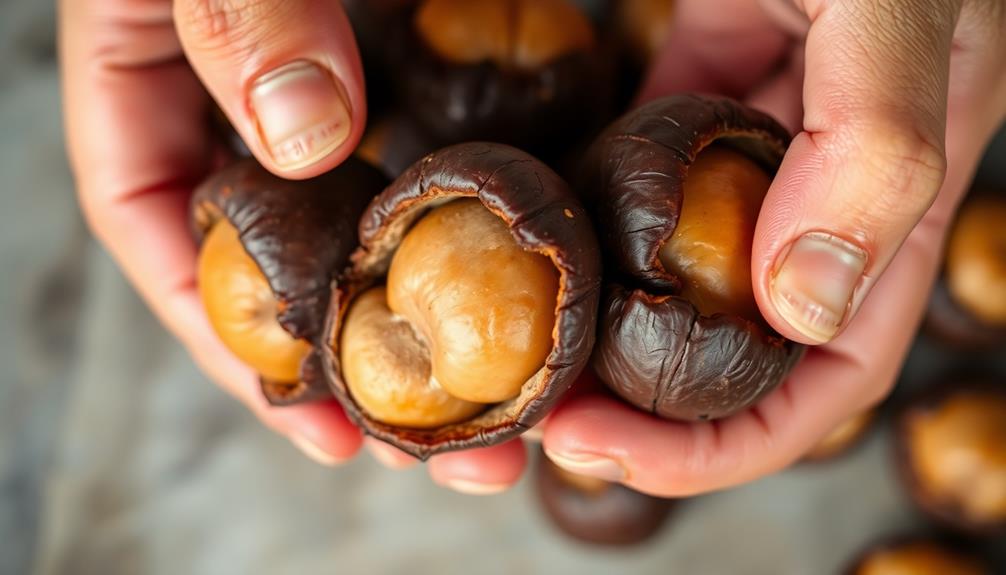
Once the chestnuts have finished roasting, it's essential to peel them while they're still warm. The warm temperature makes the shells and inner skins much easier to remove.
Carefully, take each chestnut and use a sharp paring knife or your fingers to peel off the outer shell. You'll notice the inner skin is quite thin and should come off easily as well. Work quickly, as the chestnuts will cool rapidly.
Be cautious, as the nuts will be hot. If the shells are stubborn, try scoring an X on the flat side before roasting to help the peeling process.
Discard any chestnuts that are shriveled or discolored, as they may be dry or spoiled. Peel all the chestnuts, then enjoy them warm, perhaps with a sprinkle of salt. The sweet, nutty flavor is at its peak immediately after peeling.
Roasted chestnuts are a delightful autumn treat best savored fresh from the oven.
Step 4. Let Chestnuts Cool Slightly
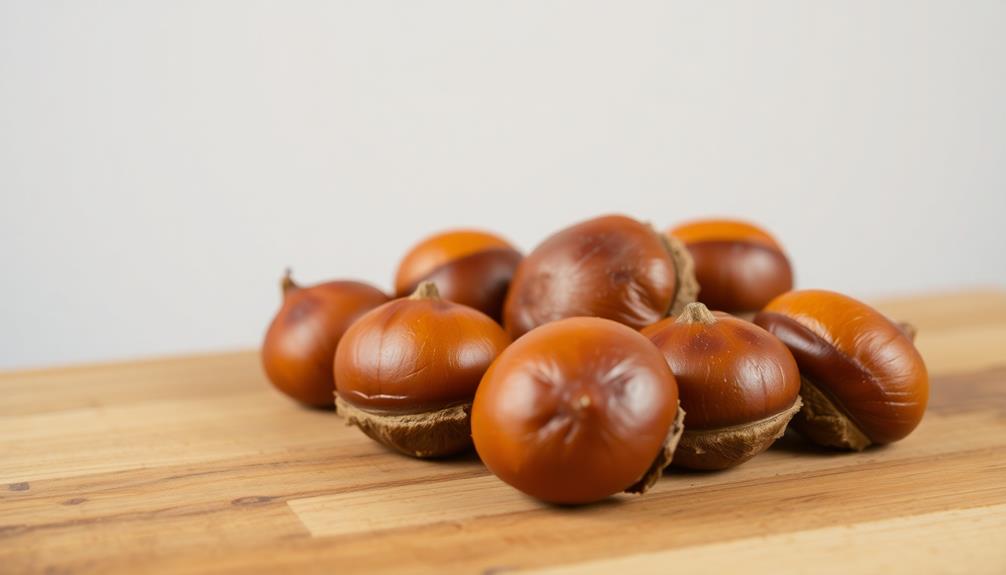
After the high-heat roasting is complete, allow the chestnuts a moment to cool slightly. This brief pause will make them easier to handle and peel.
The chestnuts' outer shells should still be hot to the touch, but not scalding. Carefully pick up one chestnut at a time, and gently squeeze it between your thumb and fingers. This light pressure will cause the shell to crack and peel away.
Work quickly, as the chestnuts will continue to cool and become more challenging to peel. Aim to remove the outer shell and inner skin in one smooth motion. If the skin sticks, use a small knife to gently pry it off.
Once peeled, the sweet, creamy chestnut meat will be ready to enjoy. Repeat this process with the remaining chestnuts, being mindful not to let them cool completely.
Warm, freshly roasted chestnuts are a true delight, so savor each one while their texture and flavor are at their peak.
Step 5. Enjoy the Roasted Chestnuts
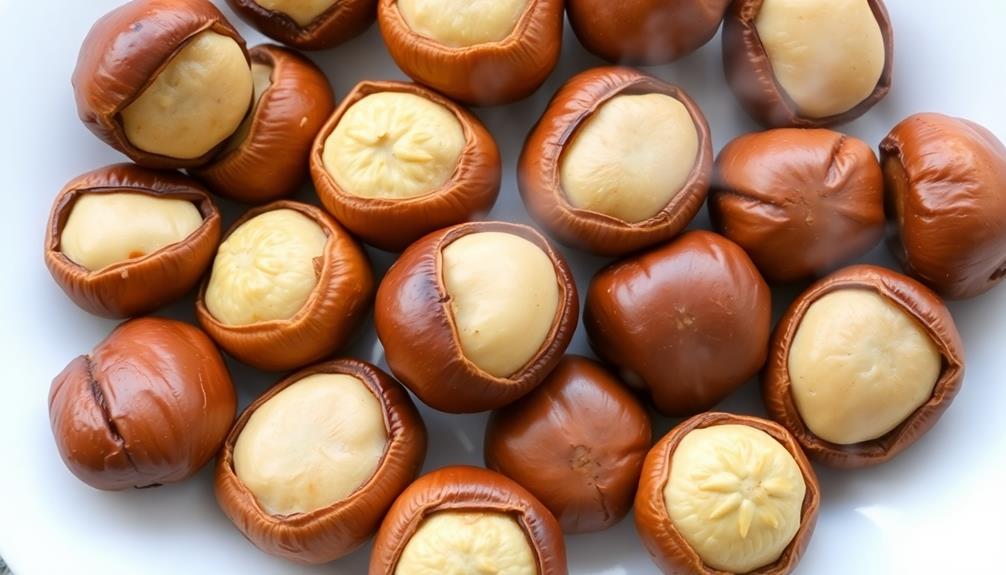
Now that the chestnuts have cooled slightly, you can begin to savor their warm, sweet, and creamy flavor. Gently squeeze each chestnut between your fingers, and peel back the outer shell and inner skin. Be careful, as the chestnuts are still hot. Discard the shells and skins, and enjoy the soft, tender flesh inside.
As you bite into the roasted chestnuts, you'll be rewarded with a burst of nutty, caramelized sweetness. The texture is unique – slightly crunchy on the outside, but smooth and velvety on the inside.
The roasting process has transformed the once-starchy chestnuts into a delightful autumn treat. Savor each morsel, letting the flavors dance on your tongue.
The warm, comforting taste of roasted chestnuts is the perfect accompaniment to a crisp fall day. Indulge in this seasonal delicacy, and let the flavors transport you to a cozy, autumnal scene.
Final Thoughts
As you tuck into the final, satisfying bites of your roasted chestnuts, you can't help but reflect on the simple pleasure of this time-honored delicacy. The aroma, the warmth, the toasty crunch – it all combines to create a moment of pure, unadulterated joy.
Roasted chestnuts are a reminder that sometimes the best things in life are the most uncomplicated. They transport you back to childhood memories, to bustling city streets, to cozy autumn afternoons.
With each bite, you savor the flavors of the season, the changing of the leaves, the approach of winter. Roasted chestnuts are more than just a snack – they're a connection to tradition, to community, to the natural rhythms of the world around us.
As you set down the empty shells, you feel a sense of contentment, knowing that you've indulged in a truly special culinary experience.
Roasted chestnuts are a timeless treat, and one that will continue to delight for generations to come.
Frequently Asked Questions
How Do I Select the Best Chestnuts for Roasting?
When selecting chestnuts for roasting, look for ones that are firm, unblemished, and heavy for their size. Avoid any that seem lightweight, shriveled, or cracked. Choose the freshest chestnuts you can find to ensure the best flavor and texture.
Can I Roast Chestnuts in the Oven Instead of an Open Fire?
You can definitely roast chestnuts in the oven instead of an open fire. Just remember to score them first and roast them at a high temperature until they're tender and fragrant.
How Long Do Roasted Chestnuts Stay Fresh After Cooking?
Roasted chestnuts will stay fresh for 3-5 days after cooking if stored in an airtight container at room temperature. You can enjoy their delightful flavor and texture for several days following your roasting session.
Can I Freeze Roasted Chestnuts for Later Use?
You can absolutely freeze roasted chestnuts for later use. Simply let them cool completely, then store them in an airtight container or freezer bag. They'll keep in the freezer for up to 6 months.
What Is the Nutritional Value of Roasted Chestnuts?
Roasted chestnuts are a nutritious treat! They're high in fiber, vitamins, and minerals like vitamin C, potassium, and magnesium. Plus, they're low in fat and calories, making them a healthy snack option. Give them a try!




